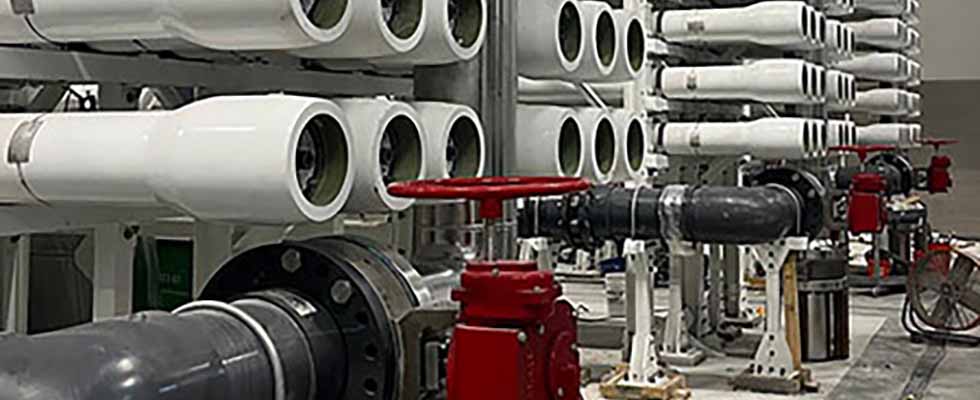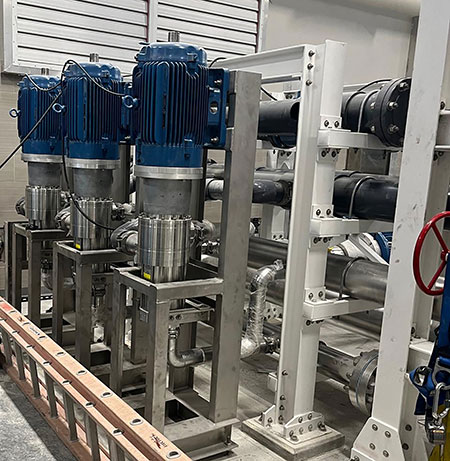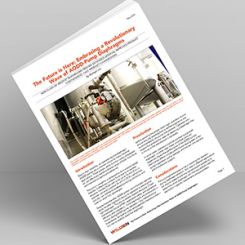
The Florida Keys Aqueduct Authority (FKAA) is launching a hurricane-proof seawater reverse osmosis (SWRO) plant that slashes energy consumption by 66% while doubling capacity. Designed for climate resilience, the updated Kermit H. Lewin Water Treatment Plant uses positive displacement high-pressure pumps and isobaric energy recovery devices (ERDs) to cut specific energy consumption (SEC) to 2.27 kilowatts per hour by meters cubed (kWh/m³). Expected online in the second quarter of 2025, the plant sets a benchmark for energy-efficient desalination in storm-prone regions.
A SWRO Is a Critical Lifeline for the Florida Keys
For over four decades, the FKAA has relied on the Kermit H. Lewin Water Treatment Plant’s SWRO facility as a backup water supply for its nearly 80,000 residents. While most of the region’s potable water comes from mainland aquifers, hurricanes and other emergencies can disrupt the pipeline system, making local desalination a vital element in the island chain’s safety net.
Now, FKAA is preparing to launch a newly upgraded, hurricane-proof SWRO facility. The new Kermit H. Lewin Plant not only doubles its previous capacity but also slashes SEC by 66%, making it one of the most energy-efficient facilities of its kind.
A New Plant Built to Withstand Weather at Its Worst
The plant’s origins date back to 1981, when FKAA commissioned the world’s largest single-pass SWRO plant at the time. However, the completion of a mainland pipeline in 1982 led to the plant being mothballed in 1988, with FKAA developing a plan to reactivate it within 48 hours after hurricanes.
Over the years, as extreme weather events became more frequent and severe, FKAA prioritized resilience. After devastating hurricanes in 1992 and 1999, the plant underwent refurbishments, but it became clear that a full-scale modernization was necessary. In 2021, FKAA secured funding, including a $48 million Environmental Protection Agency (EPA) Water Infrastructure Finance and Innovation Act (WIFIA) loan and a $30.7 million state disaster recovery grant, to build an entirely new facility, replacing the existing treatment plant with a Category 5 hurricane-proof structure.

The new plant is a 4 million gallons per day (mgd) (15,140 m³/day) facility housed in a 16,400 feet² (1,524 m²) reinforced concrete building. All critical water treatment equipment—except pretreatment—is located on an elevated platform 20 feet (6 meters) above base flood elevation, ensuring operations remain uninterrupted even during 25-year flood events and wave action.
A Century-Long Pursuit of Energy-Efficient Desalination
FKAA’s new facility is part of a long history of making seawater desalination less energy-intensive and more cost-effective while reducing its carbon footprint.
From thermal distillation methods like multistage flash (MSF) to the invention of reverse osmosis (RO) membranes in the 1960s, the push for greater efficiency has been continuous. Innovations such as thin-film composite membranes, isobaric ERDs and axial-piston pumps have helped drive energy consumption to its lowest levels ever—now approaching sub-2 kWh/m³ in the most efficient SWRO plants.
FKAA’s upgraded facility reflects this ongoing trend, demonstrating how modern high-efficiency pumps and ERDs are making desalination more viable, sustainable and cost-effective.
Built for Reliability: Redundancy & Standardization
With FKAA’s SWRO plant serving as an emergency water supply, system reliability and maintainability are top priorities. Several key strategies were implemented to ensure maximum uptime:
- Parallel pump configuration: Each of the four RO trains features two smaller high-pressure pumps instead of a single large one, providing built-in redundancy.
- Spare parts availability: Standardized equipment ensures FKAA can keep essential replacement components in stock to avoid supply chain delays.
- On-site power generation: A separate generator building houses four 1,000-1,500 kW diesel generators, ensuring the plant can operate off-grid if necessary.
Tripling Energy Efficiency
While storm resilience was a key driver of the project, energy efficiency played an equally important role. FKAA’s previous desalination plant operated with older centrifugal high-pressure pumps and turbine-based ERDs, consuming 6.77 kWh/m³ of desalinated water.
While this was acceptable when the plant was first commissioned, technology developed over the ensuing decades enables better energy efficiency that can dramatically reduce SWRO’s financial and environmental costs.
Thus, the new Kermit H. Lewin Water Treatment Plant upgraded its system with:
- Positive displacement high-pressure pumps to replace the older centrifugal pump type.
- Active isobaric ERDs to replace the older turbine-based ERD.
This high-efficiency setup reduces SEC to just 2.27 kWh/m³ (8.6 kWh/kilogallon [kgal]—a remarkable 66% improvement. It also cuts operational costs and carbon footprint while doubling output to 4 mgd.
According to the project’s engineering firm, the smaller positive displacement pumps were easier to handle, maintain and install. Furthermore, using multiple, smaller pumps per train lowered the cost of maintaining spare units for reliability.
The Role of Positive Displacement Pumps in High-Efficiency SWRO
For decades, centrifugal pumps were the standard in desalination due to their high flow capacity and proven reliability. However, positive displacement pumps now provide advantages in small- to mid-sized SWRO plants, as well as some larger plants with multitrain designs.
Key advantages of positive displacement high-pressure pumps:
- Higher energy efficiency: Positive displacement pumps consistently deliver up to 20% lower power consumption than centrifugal pumps, especially in plants with variable feed conditions. This is due to lower internal losses in positive displacement pumps that are engineered with tight tolerances to minimize internal leakage and wasted energy.
- Constant flow rate: Positive displacement pumps maintain steady performance even with salinity and pressure fluctuations.
- Redundancy and scalability in multitrain plants: In larger facilities, multiple smaller positive displacement pumps per train enhance redundancy, reduce maintenance complexity and improve operational flexibility.
- Compact and modular: With their smaller footprint, positive displacement pumps allow for easier installation and maintenance.
At the new Kermit H. Lewin Water Treatment Plant, each of the plant’s four RO trains is equipped with two axial-piston pumps. This multipump, multitrain configuration improves resilience and maintainability—allowing continued operation if one pump requires servicing—while also reducing costs by making it feasible to keep spare pumps in stock.
This modular approach is common in large SWRO plants, where multiple independent RO trains ensure greater operational flexibility, easier maintenance scheduling and system reliability.
Energy Recovery With Active ERDs
Another major efficiency driver is the adoption of active isobaric ERDs, which replace the plant’s older, turbine-based ERD system.
In an isobaric ERD, high-pressure brine from the membrane reject stream transfers its energy to incoming seawater, reducing the flow demand on the high-pressure pumps and substantially lowering energy consumption. However, during this exchange, some mixing occurs between the two streams. If not properly controlled, this mixing can:
- Increase salinity in the feedwater entering the membranes, raising osmotic pressure and energy demand.
- Affect system efficiency by requiring more work from high-pressure pumps.
- Active ERDs address these challenges by incorporating a motor and precision control system that minimizes unwanted mixing.
This ensures that:
- The brine and incoming feedwater remain at optimal pressure and salinity levels before entering the membrane stage.
- The high-pressure pump workload is reduced, cutting energy consumption.

By optimizing the mixing ratio, active ERDs improve overall system efficiency and reduce power consumption, making them a key component in modern high-efficiency SWRO plants such as FKAA’s new facility, where each of the four RO trains is equipped with three active ERDs.
A Model for Future Coastal Desalination Plants
As coastal communities worldwide face increasing climate risks, FKAA’s Kermit H. Lewin Water Treatment Plant stands as a model for how municipalities can invest in energy-efficient, stormproof water security.

